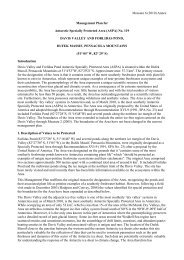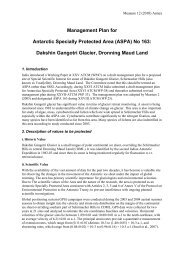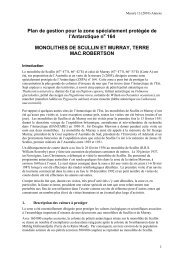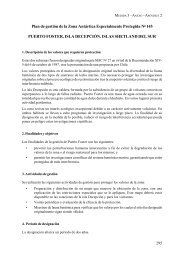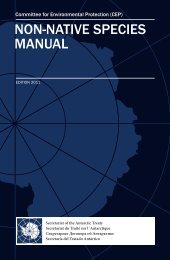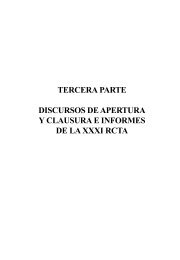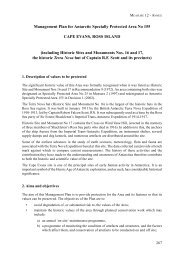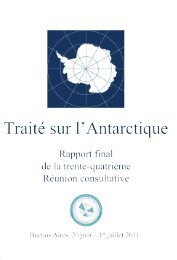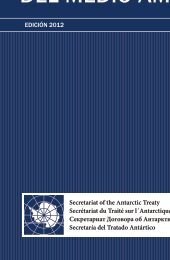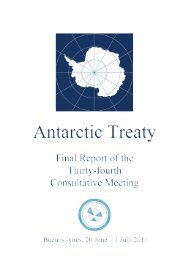Scott Base and McMurdo Station - Antarctic Treaty Secretariat
Scott Base and McMurdo Station - Antarctic Treaty Secretariat
Scott Base and McMurdo Station - Antarctic Treaty Secretariat
You also want an ePaper? Increase the reach of your titles
YUMPU automatically turns print PDFs into web optimized ePapers that Google loves.
From the transition zone the fuel is carried in flexible fuel lines rolled out according to the distance <strong>and</strong> routerequired. Many kilometres of flexible fuel line are held on station to allow this <strong>and</strong> currently the Williams Fieldline is approximately 10 kilometres in length. The flexible fuel line is supported by flotation bags where it crossesopen water, <strong>and</strong> rests on the snow surface of the ice shelf. The flexible fuel line is subject to weekly inspectionduring summer, <strong>and</strong> is rolled up <strong>and</strong> removed following the completion of the annual aviation program. Theflexible <strong>and</strong> rigid fuel lines are pigged for winterisation.All pumps <strong>and</strong> tanks are monitored during fuel transfer operations <strong>and</strong> accounting for fuel is done at each end ofthe delivery system by the fuel h<strong>and</strong>lers. Another group is responsible for maintaining the integrity of theinfrastructure such as the tanks, fuel lines, pumps <strong>and</strong> valves. Spill response is the responsibility of a further group.VehiclesBecause of the complexity of the logistic support activities at <strong>McMurdo</strong> <strong>Station</strong> <strong>and</strong> the distances involved betweenfacilities to be supported, there is a very large fleet of vehicles. There is also a large quantity of heavy earthmoving <strong>and</strong>cargo h<strong>and</strong>ling vehicles. St<strong>and</strong>ardisation only appears to have occurred with the newer personnel transport vehicles.On the whole, the fleet of vehicles <strong>and</strong> mobile plant <strong>and</strong> equipment appears to be in good working order. At a parkingarea on the flanks of Observation Hill there is a large collection of old prime movers <strong>and</strong> trucks which, while possiblyserviceable, appear to have had little recent use. The National Science Foundation subsequently advised that thesespecial vehicles are required only during vessel unloading operations, which occur annually in early February.Road gravelGravel <strong>and</strong> fines for maintaining the roads at <strong>McMurdo</strong> <strong>Station</strong> <strong>and</strong> for levelling the ground around buildingsappears to be collected by simple excavation of the naturally loose surface material which is composed of volcanicscoria. There is ample evidence of earth moving in the valleys <strong>and</strong> flanks of the small hills around the station. Theunaffected areas are characterised by the presence of erratic boulders.We were advised that dust control on the <strong>McMurdo</strong> <strong>Station</strong> road network no longer involves spraying the roadsurfaces with oil.Ice wharf at Winter Quarters BayThe ice wharf is used to allow vessels to tie up to a secure mooring <strong>and</strong> to discharge onto a level surface directlyonto cargo h<strong>and</strong>ling vehicles. Construction of the ice wharf is achieved by a matrix of ice <strong>and</strong> gravels tied togetherwith steel cables. Bollards <strong>and</strong> other equipment are embedded into the ice wharf during construction. We wereadvised that when the ice wharf reaches the end of its safe life it is cut loose <strong>and</strong> allowed to drift away as part of thepack ice field of <strong>McMurdo</strong> Sound <strong>and</strong> eventually disappear at sea, taking with it the embedded cables. The permitfor this activity requires that before being released the ice wharf must be fitted with a satellite-tracking device.Civilian contractorThe great majority of personnel at <strong>McMurdo</strong> <strong>Station</strong> are employees of Raytheon Polar Services Company, acivilian contractor operating the bulk of the United States <strong>Antarctic</strong> Program on behalf of the National ScienceFoundation. Many of the key contractor staff have been associated with the United States <strong>Antarctic</strong> Program overa number of years <strong>and</strong> have served under previous contractors. This approach has provided benefits inmaintaining a highly skilled <strong>and</strong> experienced workforce, essential in a specialised <strong>and</strong> complex operation. TheAustralian observer team was impressed by the high proportion of women in the <strong>McMurdo</strong> <strong>Station</strong> workforce,including in occupations that elsewhere in the world are not traditionally attractive to women. This provides anormality to the station population not often enjoyed at other <strong>Antarctic</strong> stations.Cooperation with <strong>Scott</strong> <strong>Base</strong>There is close cooperation between <strong>McMurdo</strong> <strong>Station</strong> <strong>and</strong> <strong>Scott</strong> <strong>Base</strong>. The Australian observer team wasprivileged to be invited to the weekly coordination meeting on 24 January 2005.Future development of <strong>McMurdo</strong> <strong>Station</strong>There are no immediate plans for large scale upgrading of the buildings at <strong>McMurdo</strong> <strong>Station</strong>. However, effort iscontinuing on a program of modernising the infrastructure to improve reliability <strong>and</strong> environmentalperformance. This is evident, for example, in the effort being put into upgrading the fuel h<strong>and</strong>ling systems <strong>and</strong>improvements to the efficiency of the power generation system.Consistency with <strong>Treaty</strong> exchange informationThe Australian observer team noted that activities at <strong>McMurdo</strong> <strong>Station</strong> are consistent with the informationprovided in the United States’ advance exchange of information circulated in accordance with Article VII.5 ofthe <strong>Antarctic</strong> <strong>Treaty</strong>.



